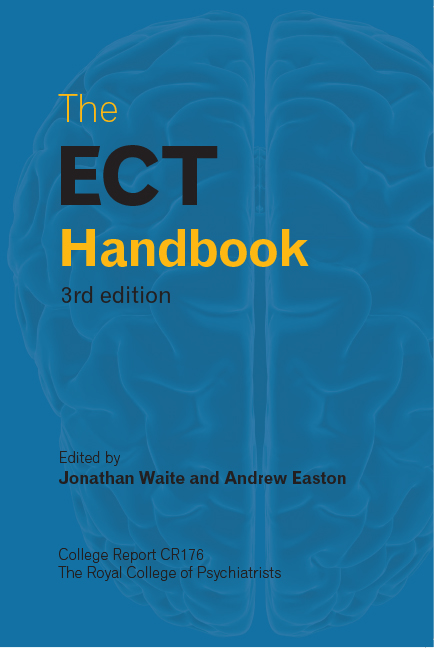Book contents
- Frontmatter
- Contents
- Abbreviations
- List of figures, tables and boxes
- List of contributors
- Preface
- Introduction: the role of ECT in contemporary psychiatry: Royal College of Psychiatrists’ Special Committee on ECT and Related Treatments
- 1 Mechanism of action of ECT
- 2 The ECT suite
- 3 Anaesthesia for ECT
- 4 ECT prescribing and practice
- 5 Psychotropic drug treatment during and after ECT
- 6 Monitoring a course of ECT
- 7 Non-cognitive adverse effects of ECT
- 8 Cognitive adverse effects of ECT
- 9 Dental issues related to ECT
- 10 Training, supervision and professional development: achieving competency
- 11 Nursing guidelines for ECT
- 12 Inspection of ECT clinics
- 13 Other brain stimulation treatments
- 14 The use of ECT in the treatment of depression
- 15 The use of ECT in the treatment of mania
- 16 The use of ECT in the treatment of schizophrenia and catatonia
- 17 The use of ECT in neuropsychiatric disorders
- 18 The use of ECT in people with intellectual disability
- 19 Safe ECT practice in people with a physical illness
- 20 ECT for older adults
- 21 The use of ECT as continuation or maintenance treatment
- 22 Consent, capacity and the law
- 23 Patients’ and carers’ perspectives on ECT
- Appendix I Out-patient declaration form
- Appendix II ECT competencies for doctors
- Appendix III Example of a job description for an ECT nurse specialist
- Appendix IV Example of a job description for an ECT nurse/ECT coordinator
- Appendix V Information for patients and carers
- Appendix VI Example of a consent form
- Appendix VII Useful contacts
- Appendix VIII Example of a certificate of incapacity
- Index
8 - Cognitive adverse effects of ECT
- Frontmatter
- Contents
- Abbreviations
- List of figures, tables and boxes
- List of contributors
- Preface
- Introduction: the role of ECT in contemporary psychiatry: Royal College of Psychiatrists’ Special Committee on ECT and Related Treatments
- 1 Mechanism of action of ECT
- 2 The ECT suite
- 3 Anaesthesia for ECT
- 4 ECT prescribing and practice
- 5 Psychotropic drug treatment during and after ECT
- 6 Monitoring a course of ECT
- 7 Non-cognitive adverse effects of ECT
- 8 Cognitive adverse effects of ECT
- 9 Dental issues related to ECT
- 10 Training, supervision and professional development: achieving competency
- 11 Nursing guidelines for ECT
- 12 Inspection of ECT clinics
- 13 Other brain stimulation treatments
- 14 The use of ECT in the treatment of depression
- 15 The use of ECT in the treatment of mania
- 16 The use of ECT in the treatment of schizophrenia and catatonia
- 17 The use of ECT in neuropsychiatric disorders
- 18 The use of ECT in people with intellectual disability
- 19 Safe ECT practice in people with a physical illness
- 20 ECT for older adults
- 21 The use of ECT as continuation or maintenance treatment
- 22 Consent, capacity and the law
- 23 Patients’ and carers’ perspectives on ECT
- Appendix I Out-patient declaration form
- Appendix II ECT competencies for doctors
- Appendix III Example of a job description for an ECT nurse specialist
- Appendix IV Example of a job description for an ECT nurse/ECT coordinator
- Appendix V Information for patients and carers
- Appendix VI Example of a consent form
- Appendix VII Useful contacts
- Appendix VIII Example of a certificate of incapacity
- Index
Summary
The study of the impact of ECT on memory begins with Janis's studies (1950), when most ECT was given unmodified and with a sine wave stimulus. Sine wave ECT has not been used in the UK for the past 25 years, although it is still used around the world and, surprisingly, still used in the USA (Sackeim et al, 2007). Previous reviews have combined studies undertaken using different electrode placements (see Chapter 4) and different pulse widths, which has made the interpretation of the nature and severity of memory impairment difficult to assess. The recommendations in this chapter are based on studies that have used brief pulse and ultra-brief pulse stimuli carried out mainly from the mid-1980s onwards.
A couple of studies that do not quite fit into the mould are worthy of comment. Ottoson's (1960) landmark research compared three groups with case-matched controls. The groups were high-dose bilateral ECT, a suprathreshold group and a group where the seizure was triggered with a suprathreshold stimulus and then aborted by intravenous lidocaine. The results led to the influential conclusion that it was the electricity rather than the seizure that caused memory impairment, because the high-dose stimulus caused more memory impairment than the suprathreshold and shortening the seizure length with lidocaine did not protect memory. These results have not entirely been borne out by more modern research and are difficult to interpret because Ottoson used a partial (quarter-wave) sine wave stimulus which lies somewhere between traditional sine wave and brief-pulse stimulus. Further research in this area has not clarified the situation. For example:
• Weiner et al (1986) found no relationship between stimulus dose and autobiographical memory using brief pulse unilateral and bilateral ECT
• Coffey et al (1990) found no relationship between electrical dose and Wechsler Memory Scale scores or time to orientation using brief pulse right unilateral ECT
• Miller et al (1985) found a significant relationship between memory impairment and seizure duration with brief pulse right unilateral ECT
• Sackeim et al (1986) found a significant correlation between seizure duration and post-ictal disorientation brief pulse right unilateral ECT
• Calev et al (1991) found a significant correlation between seizure duration and post-ictal disorientation using brief pulse bitemporal ECT.
- Type
- Chapter
- Information
- The ECT Handbook , pp. 76 - 86Publisher: Royal College of PsychiatristsFirst published in: 2017



